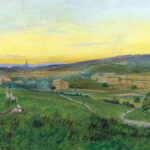5 August 1661: John Ray visits Copgrove (Harrogate), the pauper’s spa
John Ray and William Derham. 1760. Select Remains of the Learned John Ray, With His Life. London: George Scott. Get it:
.Unedited excerpt
The excerpt in the book is shorter, edited and, where applicable, translated.
[From the sulphur well at Harrogate] we went to St. Mugnus his well at Copgrave, whither a great number of poor people resort to bathe themselves. They put on their shirts wetted in the water, letting them dry upon their backs. This water operates (if at all) by its extraordinary coldness and astringency.
Comment
Comment
P.D. Hartley is good:
It can hardly have been by chance that in 1626 Dr Edmund Deane found it necessary, in his Spadacrene Anglia to blast off a broadside against this ‘innefectual superstitious relique of Popery’, for people were coming from far and wide to seek a cure for their ills in the miraculous waters of St Mungo’s Well… An entry in the Copgrove Parish Register gives a rather sad insight into the fact that St Mungo’s holy water was more mystical than medical: ‘A stranger Yt. came to Ye well was buried May 27 1710’
Something to say? Get in touch
Similar
 5 August 1661: John Ray is told that a knocked-through lighting niche in the Anglo-Saxon crypt under Ripon minster is a chastity test device
5 August 1661: John Ray is told that a knocked-through lighting niche in the Anglo-Saxon crypt under Ripon minster is a chastity test device 10 March 1665: Blizzards and Dutch attacks prolong Restoration-induced shortages of fodder and coal at Northowram (Halifax)
10 March 1665: Blizzards and Dutch attacks prolong Restoration-induced shortages of fodder and coal at Northowram (Halifax)
Comment
Comment
If Terry was fooled, then so were Fortnum & Mason etc etc:
Fraudster made £550,000 selling fake ‘Scottish-grown tea’
A fraudster who tricked luxury hotels and stores into buying “Scottish-grown tea” that was grown abroad has been found guilty of a £550,000 scam.
Thomas Robinson supplied high-end customers such as Edinburgh’s Balmoral Hotel and the Dorchester in London with varieties with names like Dalreoch White, Highland Green, Silver Needles and Scottish Antlers Tea.
Trading as The Wee Tea Plantation, he claimed they had been grown on farmland in Perthshire.
Instead, the tea had been imported, repackaged and then resold at hugely-inflated prices, Falkirk Sheriff Court was told.
Robinson also defrauded genuine aspiring Scottish tea growers by selling them plants he claimed were grown in Scotland.
Something to say? Get in touch
Search
Donate
Music & books
Place-People-Play: Childcare (and the Kazookestra) on the Headingley/Weetwood borders next to Meanwood Park.
Music from and about Yorkshire by Leeds's Singing Organ-Grinder.



 Bluesky
Bluesky Extwitter
Extwitter